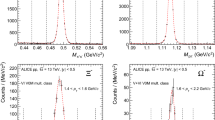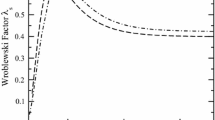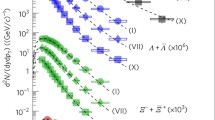Abstract
Data on the mean multiplicity of strange hadrons produced in minimum bias proton-proton and central nucleus-nucleus collisions at momenta between 2.8 and 400 GeV/c per nucleon have been compiled. The multiplicities for nucleon-nucleon interactions were constructed. The ratios of strange particle multiplicity to participant nucleon as well as to pion multiplicity are larger for central nucleus-nucleus collisions than for nucleon-nucleon interactions at all studied energies. The data at AGS energies suggest that the latter ratio saturates with increasing masses of the colliding nuclei. The strangeness to pion multiplicity ratio observed in nucleon-nucleon interactions increases with collision energy in the whole energy range studied. A qualitatively different behaviour is observed for central nucleus-nucleus collisions: the ratio rapidly increases when going from Dubna to AGS energies and changes little between AGS and SPS energies. This change in the behaviour can be related to the increase in the entropy production observed in central nucleus-nucleus collisions at the same energy range. The results are interpreted within a statistical approach. They are consistent with the hypothesis that the Quark Gluon Plasma is created at SPS energies, the critical collision energy being between AGS and SPS energies.
Similar content being viewed by others
References
T. D. Lee, Quark Matter’95, Nucl. Phys.A590 (1995) 11c.
J. C. Collins and M. J. Perry, Phys. Rev. Lett.34 (1975) 151.
E. V. Shuryak, Phys. Rep.C61 (1980) 71 andC115 (1984) 151.
Proceedings of the Eleventh International Conference on Ultra-Relativistic Nucleus-Nucleus Collisions, Quark Matter’95, Monterey, California, USA, January 9–13, 1995, eds.: A. M. Poskanzer, J. W. Harris and L. S. Schroeder, Nucl. Phys.A590 (1995).
T. Alber et al. (NA49 Collab.), Phys. Rev. Lett.75 (1995) 3814.
F. Karsch and E. Laermann, Rep. Prog. Phys.56 (1993) 1347, F. Karsch, Quark Matter’95, Nucl. Phys.A590 (1995) 367c.
P. Koch, B. Müller and J. Rafelski, Phys. Rep.142 (1986) 321.
Y. Miake and G. S. F. Stephans et al., (E802 Collab.), Z. Phys.C38 (1989) 135.
M. Gaździcki et al. (NA35 Collab.), Nucl. Phys.A498 (1989) 375c.
T. Matsui and H. Satz, Phys. Lett.178B (1986) 416.
A. Bussiere et al., (NA38 Collab.) Z. Phys.C38 (1988) 117.
M. Gaździcki and D. Röhrich, Z. Phys.C65 (1995) 215.
M. Gaździcki, Z. Phys.C66 (1995) 659.
p+p data: 2.807 GeV/c: W. J. Fickinger et al., Phys. Rev.125 (1962) 2082. 3.2 and 3.7 GeV/c: J. T. Reed et al., Phys. Rev.168 (1968) 1495. 3.349, 3.701 and 4.133 GeV/c: W. J. Hogan, P. A. Piroue and J. S. Smith, Phys. Rev.166 (1968) 1472. 3.67 GeV/c: R. I. Louttit et al., Phys. Rev.123 (1961) 1465. 4.95 GeV/c: E. Bierman, A. P. Colleraine and U. Nauenberg, Phys. Rev.147 (1966) 922. 5.52 GeV/c: G. Alexander et al., Phys. Rev.154 (1967) 1284. 6 GeV/c: R. L. Eisnev et al., Nucl. Phys.B123 (1977) 361. 6.92 GeV/c: G. Alexander et al., Nuovo Cimento53A (1968) 455. 7.87 GeV/c: M. Firebaugh et al., Phys. Rev.172 (1968) 1354. 8 GeV/c: G. Ascoli et al.,Proceedings of the Thirteenth International Conference on High-Energy Physics, Berkeley, 1966 (University of California Press, Berkeley, 1967), abstract 9.a.6. 12 GeV/c: C. W. Akerlof et al., Phys. Rev.D3 (1971) 645. 12, 24 GeV/c: V. Blobel et al., Nucl. Phys.B69 (1974) 454. 12, 24 GeV/c: M. Fesefeldt et al., Nucl. Phys.B147 (1979) 317. 12.4 GeV/c: K. Jaeger et al., Phys. Rev.D11 (1975) 1756. 19 GeV/c: P. Aahlin et al., Phys. Scripta21 (1980) 12. 19.2 GeV/c: J. V. Allaby et al.,CERN Report No. 70-12, (1970) (unpublished). 24 GeV/c: U. Amaldi et al., Nucl. Phys.B86 (1975) 403. 24.5 GeV/c: J. Bartke et al., Nuovo Cimento29 (1963) 8. 32 GeV/c: E. E. Zabrodin et al., Phys. Rev.D52 (1995) 1316. 69 GeV/c: V. V. Ammosov et al., Nucl. Phys.B115 (1976) 269. 100 GeV/c: M. Alston-Garnjost et al., Phys. Rev. Lett.35 (1975) 142. 102 GeV/c: J. W. Chapman et al., Phys. Lett.47B (1973) 465. 147 GeV/c: D. Brick et al., Nucl. Phys.B164 (1980) 1. 200 GeV/c: J. Allday et al., Z. Phys.C40 (1988) 29. 205 GeV/c: K. Jaeger et al., Phys. Rev.D11 (1975) 2405. 300 GeV/c: F. LoPinto et al., Phys. Rev.D22 (1980) 573. 300 GeV/c: A. Sheng et al., Phys. Rev.D7 (1975) 1733. 360 GeV/c: M. Asai et al., Z. Phys.C27 (1985) 11. 400 GeV/c: R. D. Kass et al., Phys. Rev.D20 (1979) 605. 405 GeV/c: H. Kichimi et al., Phys. Rev.D20 (1979) 37. 289, 498 GeV/c: Cf. [17, 18].
E. Fermi, Prog. Theor. Phys.5 (1950) 570.
A. K. Wróblewski, Acta Phys. Polonica,B16 (1985) 379.
M. Antinucci et al., Nuovo Cimento Letters6 (1973) 121 and references therein.
A.M. Rossi et al., Nucl. Phys.B84 (1975) 269 and references therein.
M. Gaździcki and O. Hansen, Nucl. Phys.A528 (1991) 754.
p+n data: 4–8 GeV/c: R. E. Ansorge et al., Phys. Rev.D10 (1974) 32. 10–24 GeV/c: R. E. Ansorge et al., Nucl. Phys.B103 (1976) 509. 11.6 GeV/c: D. Hochman et al., Nucl. Phys.B89 (1975) 383.
A+A data: 4.5 A·GeV/c: M. Anikina et al., (SKM-200 Collab.) Z. Phys.C25 (1984) 1. 11.6, 14.6 A·GeV/c: F. Videbaek et al., (E866 Collab.) Nucl. Phys.A590 (1995) 249c. 14.6 A·GeV/c: S.E. Eiseman et al. (E810 Collab.), Phys. Lett.B297 (1992) 44. 14.6 A·GeV/c: T. Abbott et al. (E802 Collab.), Phys. Rev.C50 (1994) 1024. 14.6 A·GeV/c: G. Stephans et al. (E802/E859 Collab.), Nucl. Phys.A566 (1994) 269c. 200 A·GeV/c: T. Alber et al., (NA35 Collab.) Z. Phys.C64 (1994) 195. 200 A·GeV/c: J. Bächler et al., (NA35 Collab.) Z. Phys.C58 (1993) 367.
E. Andersen et al., (NA36 Collab.) Phys. Lett.B316 (1993) 603.
E. G. Judd et al., (NA36 Collab.) Nucl. Phys.A590 (1995) 291c.
H. Bialkowska, M. Gaździcki, W. Retyk and E. Skrzypczak, Z. Phys.C55 (1992) 491.
M. Gaździcki et al. (NA35 Collab.), Nucl. Phys.A590 (1995) 197c.
J. Barrette et al. (E814 Collab.), Phys. Rev.C50 (1994) 3047.
J. Cleymans, K. Redlich, H. Satz and E. Suhonen, Z. Phys.C58 (1993) 347.
J. Sollfrank, M. Gaździcki, U. Heinz and J. Rafelski, Z. Phys.C61 (1994) 659.
J. Cleymans, D. Elliott, H. Satz and R.L. Thews, CERN preprint, CERN-TH/95-298 (1995).
L. D. Landau, Izv. Akad. Nauk SSSR78 (1953) 51.
O. D. Chernavskaya and E. L. Feinberg, Proceedings of A NATO Advanced Research Workshop onHot Hadronic Matter: Theory and Experiment, held June 27–July 1, 1994, Divonne, France, eds.: J. Letessier, H. H. Gutbrod and J. Rafelski, NATO ASI Series B: Physics Vol. 346 (1995) 117.
J. Kapusta and A. Mekjan, Phys. Rev.D33 (1986) 1304.
Author information
Authors and Affiliations
Rights and permissions
About this article
Cite this article
Gaździcki, M., Röhrich, D. Strangeness in nuclear collisions. Z. Phys. C - Particles and Fields 71, 55–63 (1996). https://doi.org/10.1007/BF02906960
Received:
Revised:
Published:
Issue Date:
DOI: https://doi.org/10.1007/BF02906960




